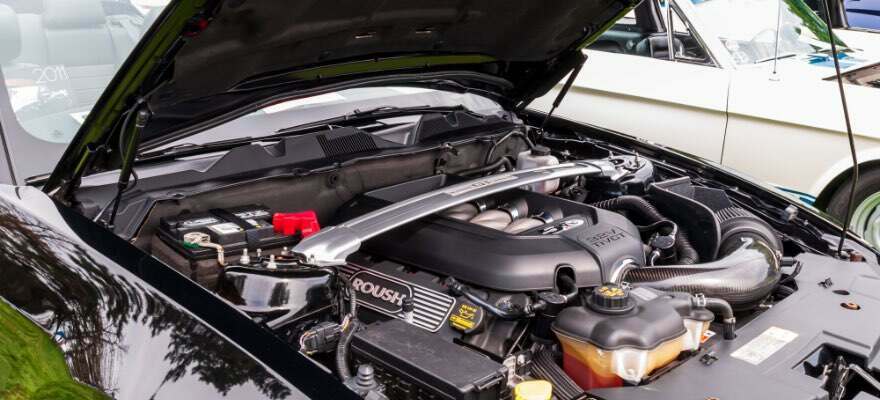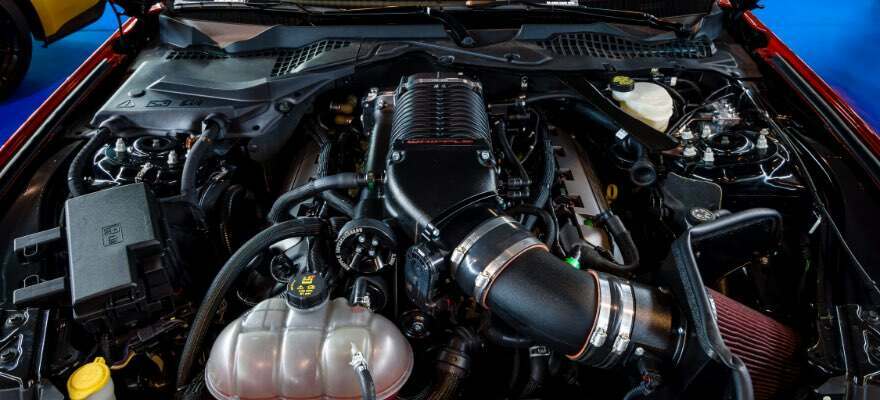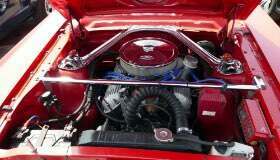As we mentioned, the Ford 5.0 Coyote engine was crafted from the Modular V8, but with some significant changes and improvements made with the Mustang GT in mind. It had to fit into the existing Mustang body, replacing the previous 4.6L 4-valve engine, and the manufacturers had to be able to produce it in a way that fits with the Modular family. However, the damn thing had to be powerful, too — to push the GT back to the head of the pony car pack.
Well, they absolutely delivered on the power front. As for the other concerns? The 5.0 Coyote, while equally powerful, wound up with a smaller displacement than the competition. Smaller meant lighter. Lighter meant faster.
Additionally, Ford had been using Variable Camshaft Timing (VCT) technology on their engines to offer better fuel efficiency and lower emissions — the 5.0 Coyote was their first V8 engine that used Twin Independent Variable Camshaft Timing (TI-VCT), which improved power and torque with the same level of efficiency. Talk about a win-win. But let's dig a little deeper to see just why the Ford Coyote engine still has us howling at the moon. Shall we?
The 5.0 Mustang Coyote Engine: A Match Made In Heaven That Was Born to Raise Hell
You know the 5.0 Coyote was built for the Mustang GT. You might even know that it's stuck around ever since. The first Mustang Coyote model was the 2011 Mustang GT, and as of this writing in 2023, it's still wreaking havoc. However, it's also gone through a few changes in that time. Below, we'll look at the 5.0 Coyote specs for each GT.

Gen 1 5.0 Coyote Engine Specs (2011-2014 Mustang GT)
The first generation of the 5.0 Coyote engine was in every 2011-2014 Mustang GT — and it was an absolute revelation to Mustang enthusiasts. The latter two model years also got a nice little bump in horsepower and some powertrain calibrations to boost overall power. These early Mustang GT Coyote engines utilized a port fuel injection system.
- Horsepower: 412 hp in 2011-2012 / 420 hp in 2013-2014
- Redline: 7000 RPM
- Torque: 390 lb-ft
Gen 2 5.0 Coyote Engine Specs (2015-2017 Mustang GT)
In the 2015-2017 Mustang GT Coyote models, we saw some solid upgrades in power. While it wasn't a drastic change, it was clear that Ford knew they had a winner, giving it larger intake and exhaust valves, updated intake and exhaust camshaft and plenty of tweaks to allow for higher RPMs.
- Horsepower: 435 hp
- Redline: 7000 RPM
- Torque: 400 lb-ft
Gen 3 5.0 Coyote Engine Specs (2018-2023 Mustang GT)
The third generation 5.0 Coyote engine has been a true revision, offering tons of power upgrades, bigger intake and exhaust valves, an added high-pressure direct injection system and more. It also has a larger total displacement than previous versions. We first saw this on the 2018-2019 Mustang GT models, but it's also on the now-current 2022 Mustang GT. As for the future, we'll just have to wait and see.
- Horsepower: 460 hp
- Redline: 7500 RPM
- Torque: 420 lb-ft
Gen 4 Coyote Engine Specs (2024+ Mustang GT)
It's official, the next update to the Ford 5.0 Coyote engine will be in the 2024 S650 Mustang. We're still waiting to learn more about the newest addition to the Coyote motor lineup, but things already look promising. Fourth gen Coyote engines are confirmed to make 480 hp and 415 lb-ft of torque standard in the Mustang GT. However, you can also upgrade the Mustang GT with an active-valve performance exhaust system to achieve 486 hp and 418 lb-ft of torque. The all-new Dark Horse variant will make 500 hp with a 7,500 RPM redline as standard.
Push Your Mustang GT 5.0 Coyote Engine to the Limit
5.0 Coyote Engine Variants
Where else might you find the Ford 5.0 Coyote engine besides a Mustang GT? This gnarly little beast has been popular enough to find its way into some other cars. It's also been used as a base for many other high-performance engines. Check out some of the most popular alternate versions of the 5.0 Coyote below.

Ford F-150 Coyote Engine
We know what you're thinking: "A Ford Coyote engine in a truck?" To that, we say, "Hell yeah, baby!" In fact, the F-150 has been on the 5.0 Coyote train alongside the Mustang GT since the very beginning, getting upgraded with every generation. It's not the exact same engine, however — the F-150 Coyote engine is more torque-oriented with a lower compression ratio, but it's still quite powerful But add a few performance parts and you'll really be cooking. Checking the Ford coyote engine specs for the F-150 show nice boosts in torque:
- 2011-2014 F-150: 360 horsepower with 380 lb-ft of torque
- 2015-2017 F-150: 385 horsepower with 387 lb-ft of torque
- 2018-2020 F-150: 395 horsepower with 400 lb-ft of torque
The Road Runner
The Boss 302 name is important to a lot of Mustang folks, so when Ford brought it back, they needed an engine that lived up to it. The so-called "Road Runner" was a high-performance, high-RPM monster built on the 5.0 Coyote engine block for the 2012-2013 Ford Boss 302 models. However, all the internal components were upgraded to increase the power and hit a 7500 RPM redline.
- Horsepower: 444 hp
- Torque: 380 lb-ft
The Voodoo
This is where things get really interesting. While still considered part of the Coyote family, the Voodoo actually has 5.2L displacement. It also uses flat-plane cranks that cause a bit of engine vibration, meaning it's insanely loud in the best way possible. The Voodoo is in all 2015-2020 Shelby GT350 and GT350R models, and its specs are a thing of magic.
- Horsepower: 526 hp
- Torque: 429 lb-ft
The Aluminator
Like the GT350, the Aluminator uses a 5.2L cylinder block, but it has a Cobra Jet intake manifold, cross-plane crankshaft and a few other tweaks to give it some extra rip. The Ford Performance Aluminator engine is sold independently, usually to insane people like us who want to do nothing but chew bubblegum and destroy asphalt — did we tell you we're all out of bubblegum?
- Horsepower: 580 hp
- Torque: 445 lb-ft
The Predator
It's the newest 5.2L Coyote engine variant, and the Predator doesn't bleed, so you can't kill it. This engine is good enough to be in the 2020 Shelby GT500, which is truly an honor, considering it's the most powerful production Mustang thus far.
- Horsepower: 760 hp
- Torque: 625 lb-ft
What Is Coyote Swapping?
While not officially sanctioned by Ford as 5.0 Coyote variants, the concept of "Coyote Swapping" (or doing "Coyote Swaps") is a favorite pastime for gearheads. Basically, it involves putting a high-powered, crate-style Ford Coyote engine or select components into an older Mustang, letting past generations share in the power. Plus, since earlier Mustangs had lighter bodies, the kind of speed you'll experience will take your breath away.
The most popular models for Mustang GT Coyote Swapping include:
- Fox Body Mustang (by far the most popular choice)
- SN95 Mustang
- New Edge Mustang (an underrated option that's easier to pull off)
- S197 Mustang
The most popular Coyote Swap mods include:
- Return Style Fuel System: If you're looking for a wicked Coyote Swap upgrade that delivers a complete return-style fuel system, check out the Coyote Swap Return Style Fuel System for the mighty 5.0L Coyote engine. This bad boy is based on the renowned "Budget Return Style Fuel System" dominating the scene for the current 99-04 engines. We've taken it further and made modifications to accommodate the stock Coyote fuel rails, which don't require an FRPS (fuel rail pressure sensor). This means you're getting the best of both worlds: a kick-ass fuel system that's not only proven to be cost-effective but also fine-tuned to fit your Coyote-powered beast like a glove. It's like having the perfect fuel system tailor-made for your ride.
- Ford Performance M-9000-PMCA3A: Looking for something a bit more comprehensive? Ford Performance has stepped up its game and brought you a kit that makes swapping the innovative 5.0L Coyote engine into any Ford vehicle a breeze. The Coyote Power Module Kit combines the heart-pounding 460 horsepower Mustang GT 5.0L Coyote V8 with a cutting-edge 10-speed automatic transmission and comes fully loaded with all the electronics and hardware you need to complete the installation like a pro. The engine itself is a masterpiece of engineering. With features like Direct and Port Fuel Injection, Twin Independent Variable Camshaft Timing and a lightweight plasma transferred wire arc spray aluminum engine block, you're looking at the pinnacle of power and performance.
- Gas Pedal Adapter: We've got a crucial piece of the puzzle to discuss: the Throttle Pedal. When doing a Coyote swap, mounting that pedal can be a real headache. The stock pedal unit that comes with the FRPP Controls Pack or from donor vehicles just doesn't easily adapt to the firewall of earlier cars. But fear not because Scram Speed has the solution you've been searching for. With Scram Speed's pedal adaptor, you can effortlessly install the throttle pedal at the proper angle, saving you time and headaches. Now, you can confidently tackle the mounting of the throttle pedal, knowing that you've got the right tool for the job. No more frustrations, no more wasted time. It's all about efficiency and completing that Coyote swap without a hitch.
Keep in mind that swapping a new 5.0 Coyote into an older Mustang isn't always the easiest performance mod to do. For instance, with a Fox Body, there are different approaches you can take that involve varying amounts of parts and fabrication, and you'll need to consider factors like physical size and electronic components.
See the Power of a Coyote Swap for Yourself
If you want to see how a Coyote Swap is done and the power it can provide for your early-generation Mustang, check out Lethal's very own 1000HP Coyote-10R80-Swapped 2003 SVT Cobra.
“I got ninety-nine problems, but a [Coyote] ain't one.”
- Jay-Z, sort of
Upgrade Your 5.0 Coyote Engine for Other Vehicles
Strengths and Weaknesses of the 5.0 Coyote Engine
Look, at this point, it should be pretty clear that we're huge Ford Coyote motor fans. So, we're pretty tempted to say, "Strengths = Everything, Weaknesses = Nothing." But we're trying to take off our fanboy hats here and look at this engine with a critical eye.

What Are the Biggest Strengths of the 5.0 Coyote Motor?
The 5.0 Coyote engine has a lot to offer, especially for the Mustang GT, but its most significant strengths in the grand scheme of Ford history are:
- It is incredibly easy to modify, especially when it comes to bolt-on performance modifications.
- The 5.0 Coyote engine is wildly powerful, even stock off the line.
- With some power mods, it can hit 750 horsepower at the crankshaft as long as you have the right tuning and configuration.
What Are the Weaknesses of the 5.0 Coyote?
We can confidently say that there are no Ford 5.0 engine problems big enough that you shouldn't buy, but there are some weaknesses. While the positives definitely outweigh the negatives, stock Ford 5.0 Coyote engines are weak in the following areas:
- The hypereutectic pistons are somewhat fragile and should be swapped out for forged pistons when you're modding for high horsepower.
- The oil pump gear experiences fatigue (and possible failure) when pushing into high-RPM territory, which is a major concern for heavy track use.
- Transmission issues such as slips, rough shifting and clunks can be common.
Luckily, as with most things, you can fix most of your potential 5.0 Coyote engine problems with some simple mods.
The Best Performance Upgrades for 5.0 Mustang Coyote Engine
We've sung the praises of the 5.0 Coyote engine, but we're also never satisfied. Since it's such a mod-friendly platform, there is a ton you can do to make it exactly as powerful as you want. The possibilities are nearly endless. That said, in this section, we've picked out a few of our favorite places to start with the best performance upgrades for your 5.0 Mustang Coyote engine.

First Things First: Upgrade Your Induction
A good cold air intake is one of the first 5.0 Coyote performance parts you should add to your 5.0 GT. A cold air intake allows more oxygen to flow into your engine. More air equals more combustion, which means more power.
Cold air intakes are probably the easiest Coyote performance parts to install and can add 15-20 hp and just as many lb-ft of torque right off the bat. Add to the equation that these 5.0 Coyote performance parts will increase your Mustang GT's efficiency and fuel economy; it's a no-brainer. A good exhaust (see below) with headers might give you more gains, but the CAI is the cheapest and quickest way to add power to your Pony.
If you're looking for a quality cold air intake to improve your 5.0 Coyote engine specs, check out a few of our favorites:
- Steeda HARDCORE MaxFlow: Horsepower per dollar, Steeda's MaxFlow Closed Box Cold Air Intake is a great upgrade for your 5.0L Coyote engine. Steeda has worked hard to develop a system to take your Coyote 5.0 specs to the highest level of performance. It even comes with an oiled reusable high-flow panel filter, with an optional high-flow dry filter.
- Corsa Performance Closed Box: If you're looking for the coldest, freshest air without relying on a seal from your hood, we recommend checking out the Corsa Performance Closed Box Cold Air Intake. Corsa states that this exceptional beast can give drivers an additional 20 horsepower and 11 lb-ft. of torque. These Coyote engine upgrades even feature rotomolded construction, a generous oversized air filter and inverted cone technology.
- JLT CAI-FMG-18: If you're hoping to spend a little less on your Coyote 5.0 performance parts, you may want to consider a JLT Cold Air Intake System. This system is fully computer designed to optimize space for the best fit and finish and features a large five-inch inlet filter with a radiused end for smooth airflow across the 120mm mass flow sensor. With a fully rotomolded heat shield and fresh air duct straight to the grille, these Mustang 5.0 upgrades are designed to keep inlet air temps as cool as possible.
You may also want to add more air and fuel to your engine with an intake manifold. These are some of the most popular Mustang 5.0 mods on the market today, and for a good reason. Performance intake manifolds feature far larger parts and smoother contours, which allow your Coyote motor to breathe even more freely when compared to stock, resulting in more sweet 5.0 Coyote horsepower and torque for your ride. Here are our top picks for the best air intake manifold upgrades:
- 1320 Junkie Performance Hand Ported Intake Manifold: Featuring new OEM units (not a core of another vehicle), the 1320 Junkie Performance Hand Ported Manifold is hand ported to perfection to provide you with optimal airflow for maximum power.
- Ford Performance Cobra Jet Intake Manifold: If you're interested in sticking with the Ford brand to boost your Ford Coyote engine specs, we recommend checking out the Cobra Jet Intake Manifold from Ford Performance. Based and developed on the naturally aspirated Cobra Jet Race Car, this system is one of the most popular Mustang 5.0 mods for racers and enthusiasts of all types.
A Note On CAIs and Intake Manifolds: When purchasing either of these Coyote engine parts, be aware that, in some cases, you may need a tune after installation. Since these systems allow more air into the engine, your Mustang GT's computer may not be calibrated to optimize this increase. A Mustang GT tune lets you ensure your car is set up correctly to handle the influx of additional air. Some cold air intakes and intake manifolds are designed to work with your car's stock setup right out of the box. Some are not.
Wake Up Your 5.0 (And the Neighbors) With a New Exhaust
We haven't done any scientific research on this, but new exhaust systems are probably the number one most popular performance upgrade for the 5.0 Coyote engine. A high-performance exhaust is also among the most noticeable mods for the 5.0 Coyote engine. You'll see modest gains in Mustang 5.0 HP and torque, but the real star of the show is the sound. Anyone who loves performance cars is a sucker for a deep V8 growl. And although the Mustang rolls out of the showroom with a decent set of pipes, there's no substitute for a deep, throaty rumble of a Mustang GT Exhaust System. Just like all of our 5.0 Coyote performance parts, there are a myriad of choices when it comes to choosing an exhaust.
- Axleback Exhaust Mods: This is the least expensive option when replacing your stock Mustang GT exhaust. However, it's also the least effective as far as performance gains are concerned. This is the perfect choice for a Mustang GT owner who wants more growl at an affordable price. If you want an axle-back for your 5.0L Coyote engine, we recommend checking out the MRT Engineering 91U921, Corsa Performance 21039BLK, Magnaflow 19419 or the LTH FDAB00005T.
- Cat-Back Exhaust Mods: Adding a cat-back exhaust gives you a good middle ground for performance vs. price. The increased flow from these Ford 5.0 performance upgrades will give you about a 3% increase in hp and torque and a far more aggressive (and louder) rumble over your stock pipes and mufflers. Take a look at the Corsa 3.0" Cat-Back Exhaust X-treme Sound Level, the Borla 3" Stinger S-Type, the MBRP Aluminized S7205AL or the XForce Twin 3" SS.
- Resonator Delete Mods: There are a lot of Coyote performance parts that offer a slight change in exhaust sound while prioritizing those performance gains. But if you're looking to make a statement with your exhaust, then we recommend checking out a resonator delete. Your vehicle's exhaust will take on a raspier, throatier tone that'll make heads turn. If you're looking to truly improve your sound with Mustang 5.0 performance parts, we recommend the Corsa Performance 3" Stainless Double HH-Pipe, MBRP S7213409 X-Pipe or the Ford Performance M-5251-M8 X-Pipe.
- Header Exhaust Mods: Headers are often the final (or FIRST, if you want to be literal) piece in a full-performance exhaust makeover. Headers replace the stock exhaust manifold and increase exhaust flow and cut back pressure to raise engine performance and power. And although the headers are the first 5.0 Mustang performance parts in an exhaust system, you don't typically want to start with them without having a good catback exhaust as well. A complete exhaust mod with headers provides the best performance and the nastiest (and we mean that in the BEST way possible) sound. If you need some header recommendations to boost your Ford Coyote engine specs, check out the Kooks Headers & Catted Connection Kit, the LTH FDLH00014T, the Stainless Power SM15HCAT or American Racing Headers for incredible performance boosts.
Go Big or Go Home With a Supercharger
No more playing around, buddy boy. If you're looking for the master of all 5.0 Coyote engine upgrades, then a supercharger is what you want. This is the most expensive mod you can choose, but with the big price tag comes massive gains. A supercharger kit can boost your 5.0L Mustang GT to upwards of 700 hp and more than 600 lb-ft of torque.
Lethal Performance has some great packages put together that include all the 5.0 Coyote performance parts you'll need to see gains with peak efficiency:
- Lethal Performance 1,000HP Power Pack: Whipple Superchargers shattered rules and crushed records with their mind-blowing S550 supercharger system, making it the worst supercharger system out there. We weren't satisfied with just that. We decided to go all out with the 1,000HP Power Pack – it generates a potential 1,000HP on E85 or 850HP on 93 Octane at the crank. This Gen 5 beauty sets the new standard for efficiency, making every other supercharger kit whimper in comparison.
- Lethal Performance VMP Odin Supercharger Power Package: If you're looking to spend a little less while still seeing massive gains, check out the VMP Odin Supercharger Power package. It features the legendary VMP Odin kit, customized to your liking with a sweet selection of Injectors and our kick-ass FUEL+ Pump Booster. This beast is street-ready and reliable as hell. You can install it and hit the road, feeling the rush of raw, mind-blowing power while maintaining that streetability factor. It's the perfect combination of muscle and practicality.
- Lethal Performance S550 Mustang GT and Bullit Procharger Stage II Package: If you're hungry for massive horsepower and want to keep even more extra cash in your pocket, then check out the Lethal Performance Procharger Stage II package. Our Procharger Supercharger kit is the real deal, equipped with the mighty P1SC unit and all the components you need for a complete installation. With this setup, you'll have everything you need to handle up to a mind-blowing 800 horses. Yeah, you heard us right.
Keep in mind that you don't want to just throw a supercharger under the hood and hit the pavement. You'll have too much power for your stock Mustang to handle. To benefit from everything Mustang superchargers have to offer, you'll need beefier tires, a more robust suspension and a more durable drivetrain.
Maximize Your Efficiency With a Performance Tune
Tuning is the not-so-secret secret weapon of car enthusiasts everywhere. Anyone who wants to get the most performance from their 5.0 Coyote engine is starting with a good tune. Tuning is the process of configuring your PCM for optimal performance. Even a stock Mustang will see impressive gains from a quick tune.
If you're adding aftermarket mods to your platform, then a good tune is not only recommended, it's really essential. Everything you want will pop up before your eyes. More power? Yep. Faster acceleration? Of course. Improved efficiency? Yes, indeed. When it comes to custom tunes, there's no such thing as a "one size fits all" solution. Your 5.0 Mustang's performance needs are unique to you, so we recommend checking out The Tune Shop. Whether you're craving that extra oomph in horsepower, seeking optimal fuel efficiency or desiring a blend of both, The Tune Shop has got you covered. If you want to learn more about custom tunes, check out our custom tuning FAQ.
Ford 5.0 Coyote Motor FAQs
Here's a quick glance at some of the most pressing questions and answers you might have regarding the 5.0 Coyote engine.
What Is a Coyote Engine?
The Ford Coyote engine is a 5-liter Dual Overhead cam V8 used primarily in Ford Mustang GT and F-150 platforms. The 5.0 Coyote motor, which first appeared in 2011, is naturally aspirated and a popular engine for Ford enthusiasts.
How Can I Identify a 5.0 Coyote Motor?
There are three generations of the Coyote engine that can be distinguished from one another by specific details.
- Gen 1 Coyotes (2011-2014) are most easily set apart from other generations due to the absence of charge motion control valves (CMCV) on the back of the intake manifold. Both Gen 2 and Gen 3 have these valves, which restrict airflow to create low-end torque but open up at faster acceleration to generate more horsepower.
- Gen 2 Coyote engines (2015-2017) and the Gen 1's feature a 7-quart oil pan, while the Gen 3's use a larger, 10-quart pan.
- The Gen 3 Coyote (2018-Present) has a direct-injection pump on the cylinder head's right side.
How Much Is a Coyote Engine?
You might be able to find a great deal on a used Mustang Coyote engine or pluck one from a salvage yard, but generally, the 5.0 Coyote engine's price is going to start at a little over six grand. But with more bells and whistles (and maybe a supercharger), you're talking about tens of thousands of dollars.
When Did the Coyote Engine Come Out?
The Ford 5.0 Coyote engine was introduced on the 2011 model year Ford Mustang GT and the Ford F-150 pickup.
What Does 5.0 Liter Engine Mean?
When we talk about the 5.0L engine, we're referring to the total volume (swept volume) of the engine in liters. Each cylinder has an equal displacement or volume – when you add up the volume of all those cylinders, you get a whopping 5.0L (5000cc) of pure automotive fury.
Which Upgrades for Ford Coyote Engine Should I Get?
Ultimately, choosing what Ford 5.0 performance upgrades you want depends on your specific needs. If you're looking for small gains you hope to build on later without spending too much money, a cold air intake or axle-back exhaust is your best bet. If you're ready to kick things up a notch without worrying about cost, you might want to consider adding a cat-back exhaust, headers or even a supercharger.
“...the coyotes aren't going anywhere, but the herd is, and so are the men who drive the herd.”
- Louis L'Amour, Tucker
Keep Howling With 5.0 Coyote Engine Parts From Lethal Performance
Ford is always cooking up something new, so in all reality, we don't know how much longer the 5.0 Coyote engine will give the Mustang GT its balls. But for freaks like us, the Coyote will always be around. Sure, we'll follow the Blue Oval to the gates of hell, but when something is a genuine part of Mustang history, it stays in our blood. The 5.0 Coyote engine has more than earned its place in the books. Also, check out our aftermarket upgrades like Ford Mustang wheels and rims and Mustang supercharger kits.
SHOP 5.0 COYOTE PARTS






